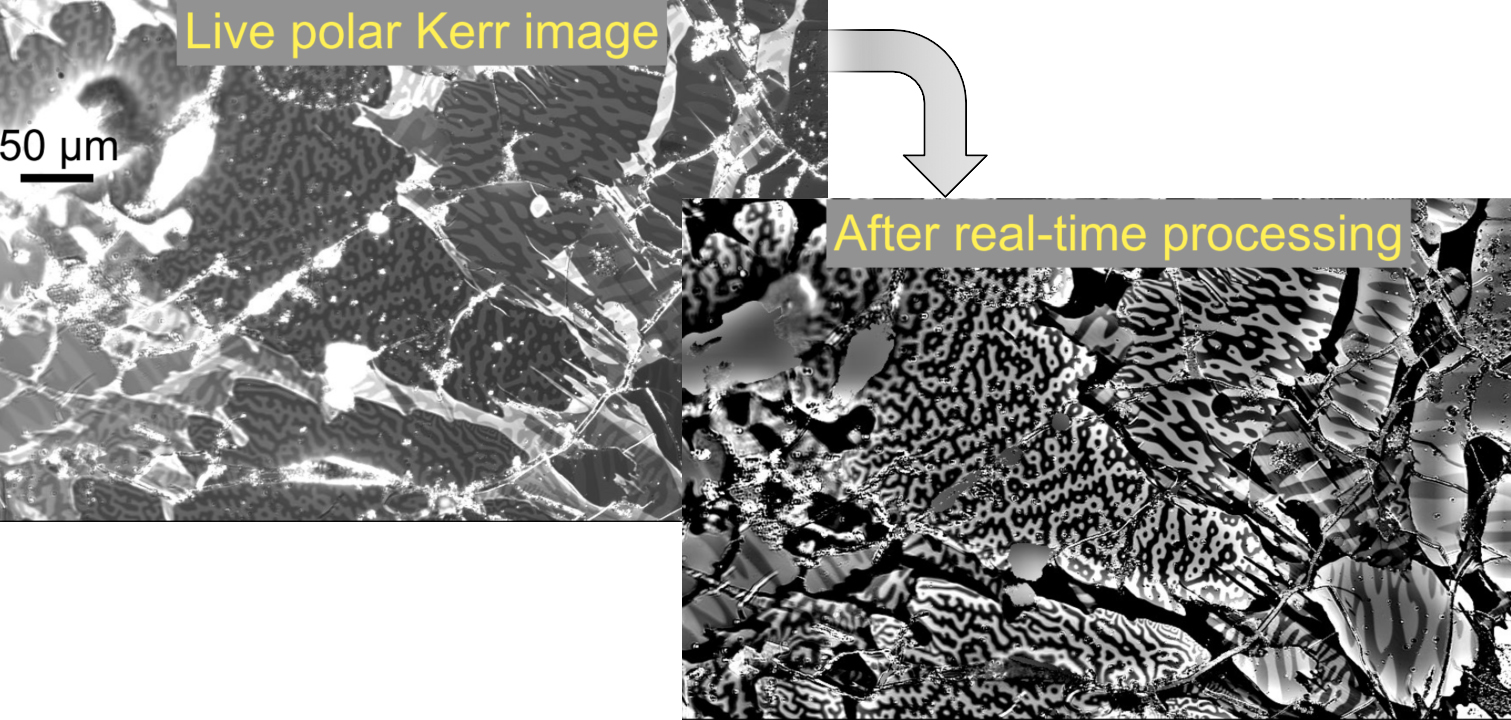
Advanced imaging of permanent magnet materials
High-quality domain images can be obtained in quasi real-time without the need to apply saturation fields for background subtraction.
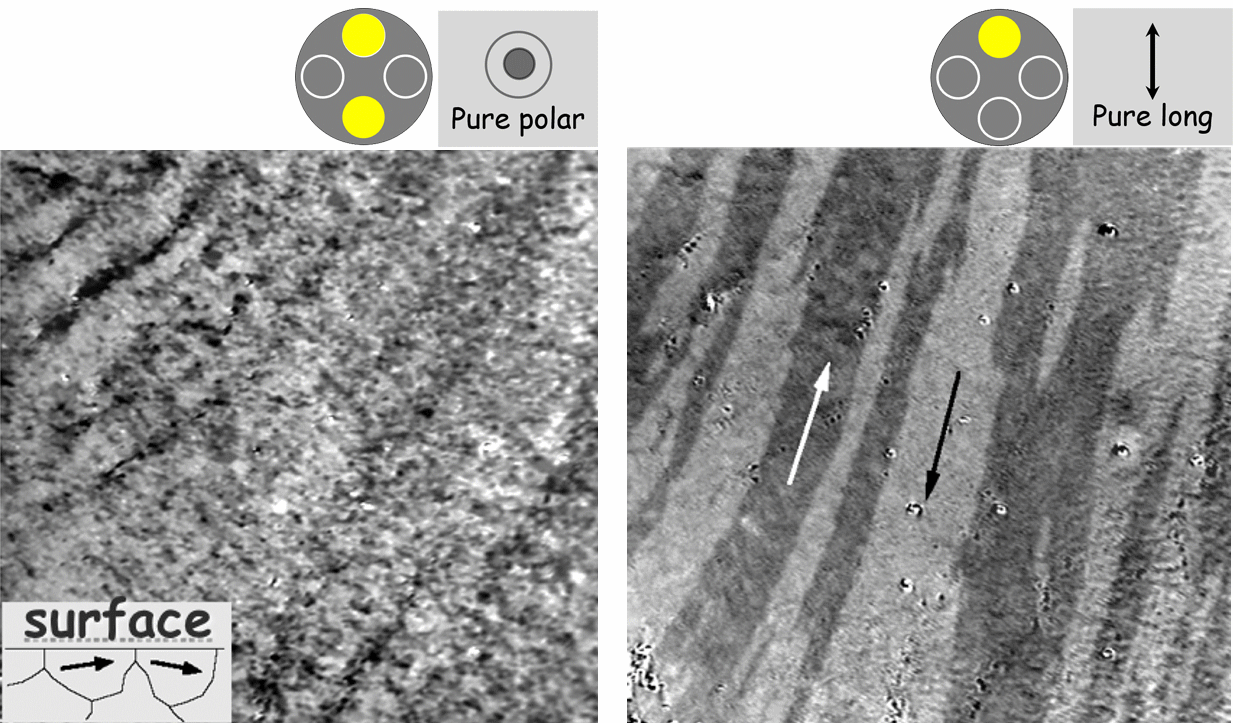
In-plane and out-of-plane contrast separation
By applying the LED-based light source, the image contrast generated by in-plane and out-of-plane components of the magnetization can be separated. This approach has been illustrative applied to observe interaction domains in fine-grained NdFeB material.
Under pure polar conditions, a complex contrast pattern with different gray levels is observed , as individual grains have different easy-axis orientations relative to the sample surface. At the same time, in pure in-plane sensitivity mode, wide in-plane magneto-static interaction domains become visible.
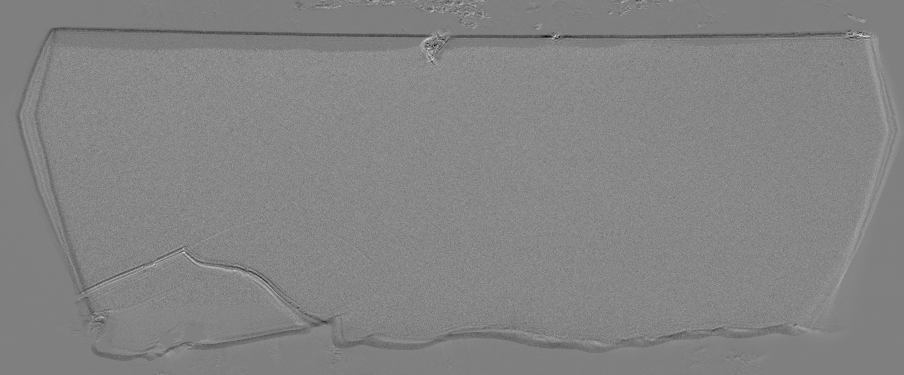
Interaction domains in NdFeB
Combined with sample stabilization, the LED-based contrast separation technique enables live observation of magnetization switching in fine-grained (~10 nm) NdFeB ribbons via propagation of interaction domains.
Some Examples
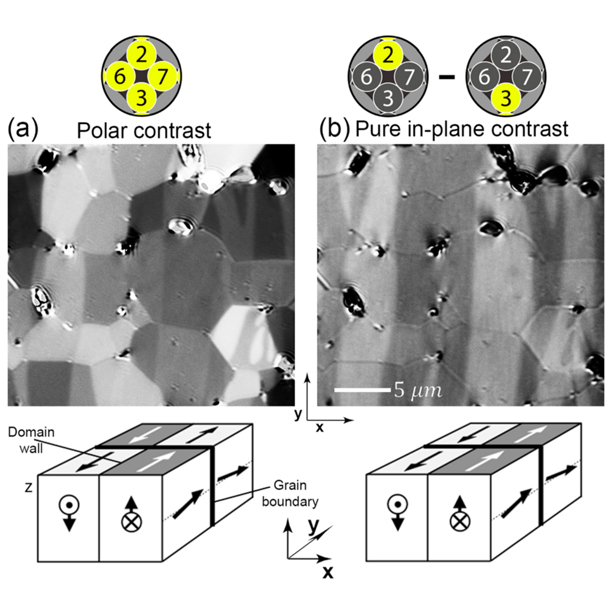
Selective sensitivity in Kerr microscopy
I. V. Soldatov and R. Schäfer,
Rev. Sci. Instrum. 88, 073701 (2017)
A new technique for contrast separation in wide-field magneto-optical Kerr microscopy is introduced. Domain images with orthogonal in-plane sensitivity are displayed simultaneously at real-time, and images with pure in-plane or polar contrast are obtained.
.
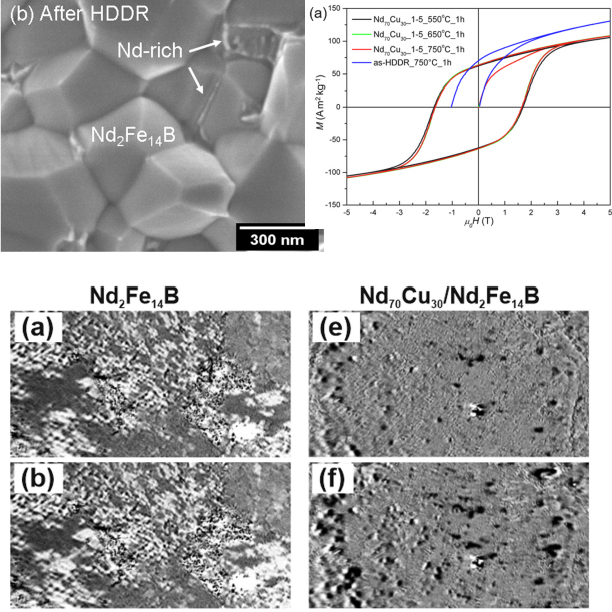
Grain boundary infiltration in HDDR processed Nd2Fe14B magnets
I. Dirba, P. Pattur, I. Soldatov, E. Adabifiroozjaei, L. Molina-Luna, O. Gutfleisch
Journal of Alloys and Compounds, 930, 167411 (2023)
We investigate the grain boundary infiltration process of various low melting eutectic alloys for the coercivity enhancement of hydrogenation disproportionation desorption recombination (HDDR) processed Nd-Fe-B powders. Nd-based as well as heavy rare earth (Tb) and light rare earth (La, Ce) containing alloys were systematically studied: Nd70Cu30, Nd90Al10, Nd80Ga15Cu5, Nd62Fe14Ga20Cu4, Nd60Tb10Cu30, La71Cu29 and Ce72Cu28. Moreover, the Fe content in the quaternary Nd-Fe-Ga-Cu system was varied to investigate the effect of grain boundary phase magnetism on the resultant coercivity.
The largest coercivity enhancement, from 0.42 T in the as-HDDR powder to 1.88 T after infiltration was observed in the case of ternary Nd80Ga15Cu5 composition. Furthermore, it also shows the best temperature stability with the infiltrated sample still exhibiting a coercivity of 0.58 T at 200 °C. Infiltration of light rare earth (La, Ce) based alloy did not increase coercivities due to poor wetting at the grain boundaries. Adding Fe to the grain boundary alloys was shown to enhance magnetization up to a certain extent without significant loss in coercivity. These findings demonstrate the effectiveness of grain boundary infiltration in HDDR-processed magnets without using heavy rare earths. The infiltration with non-magnetic material strongly decreases the intergranular interaction, reflected in a different magnetic domain evolution during the magnetization reversal process.
.
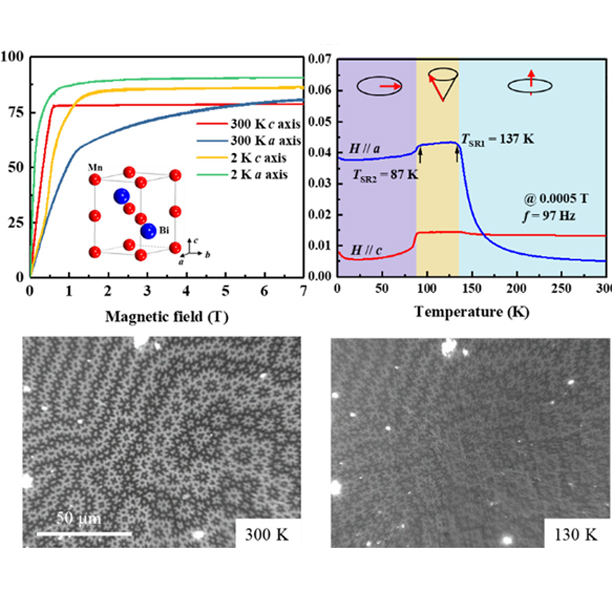
Topological Hall effect arising from the mesoscopic and microscopic non-coplanar magnetic structure in MnBi
Y. He, S. Schneider, T. Helm, J. Gayles, D. Wolf, I. Soldatov, H. Borrmann, W. Schnelle, R. Schäfer, G. H. Fecher, B. Rellinghaus, C. Felser
Acta Materialia, 226, 117619 (2022)
The topological Hall effect (THE), induced by the Berry curvature that originates from non-zero scalar spin chirality, is an important feature for mesoscopic topological structures, such as skyrmions. However, the THE might also arise from other microscopic non-coplanar spin structures in the lattice. Thus, the origin of the THE inevitably needs to be determined to fully understand skyrmions and find new host materials. Here, we examine the Hall effect in both, bulk- and micron-sized lamellar samples of MnBi. The sample size affects the temperature and field range in which the THE is detectable. Although a bulk sample exhibits the THE only upon exposure to weak fields in the easy-cone state, in micron-sized lamella the THE exists across a wide temperature range and occurs at fields near saturation. Our results show that both the non-coplanar spin structure in the lattice and topologically non-trivial skyrmion bubbles are responsible for the THE, and that the dominant mechanism depends on the sample size. Hence, the magnetic phase diagram for MnBi is size-dependent. Our study provides an example in which the THE is simultaneously induced by two mechanisms, and builds a bridge between mesoscopic and microscopic magnetic structures.
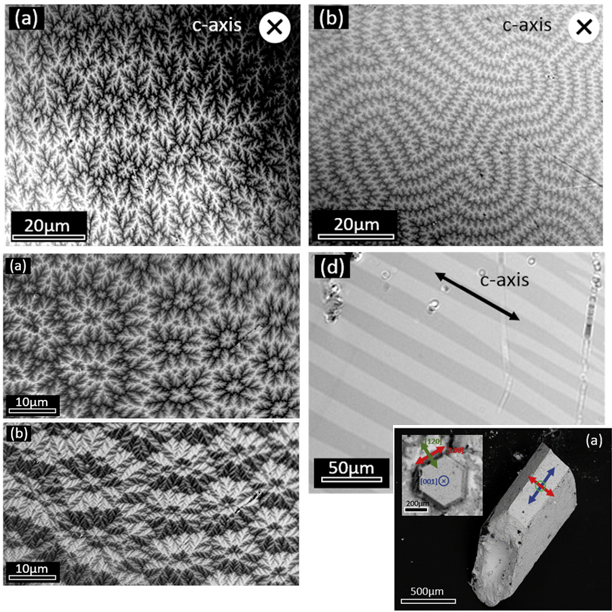
Experimental and computational analysis of binary Fe-Sn ferromagnetic compounds
B. Fayyazi, K. P. Skokov, T. Faske, I. Opahle, M. Duerrschnabel, T. Helbig, I. Soldatov, U. Rohrmann, L. Molina-Luna, K. Gueth, H. Zhang, W. Donner, R. Schäfer, O. Gutfleisch
Acta Materialia, 180, 126 (2019)
Ferromagnetic Fe3Sn, Fe5Sn3 and Fe3Sn2 single crystals were synthesized using the reactive flux technique. Derived from single crystal x-ray diffraction and Transmission Electron Microscopy (TEM), a new structural model is proposed for the Fe5Sn3 crystals – the threefold twinning of an orthorhombic unit cell with (3 + 1) dimensional space group Pbcm(α00)0s0. The spontaneous magnetization (Ms) and the anisotropy constants K1 and K2 of Fe3Sn, Fe5Sn3 and Fe3Sn2 single crystals were determined in a wide temperature range using M(H) dependencies and a modified Sucksmith-Thompson technique. Ms and K1 were also evaluated in the framework of Density Functional Theory (DFT) and an overall good agreement was observed between the calculated and experimental results. Furthermore, a critical evaluation of different analytical models for the assessment of magnetocrystalline anisotropy was performed, which are restricted to the analysis of uniaxial magnetic domain patterns, and it is shown that such high-throughput techniques can lead to unrealistic results. Finally, a DFT high-throughput screening of the Fe-Sn phase diagram was used to identify Fe-Sn based phases with potential to be stabilized upon alloying, and their magnetization and magnetocrystalline anisotropy were evaluated. The results show that a similar strong anisotropy as observed in Fe3Sn may also be found in other Fe-Sn based phases, having higher potential to be used as hard magnetic material.
The further information on combination of the electric measurements with Kerr microscopy can be found in the Papers in collabortion.
